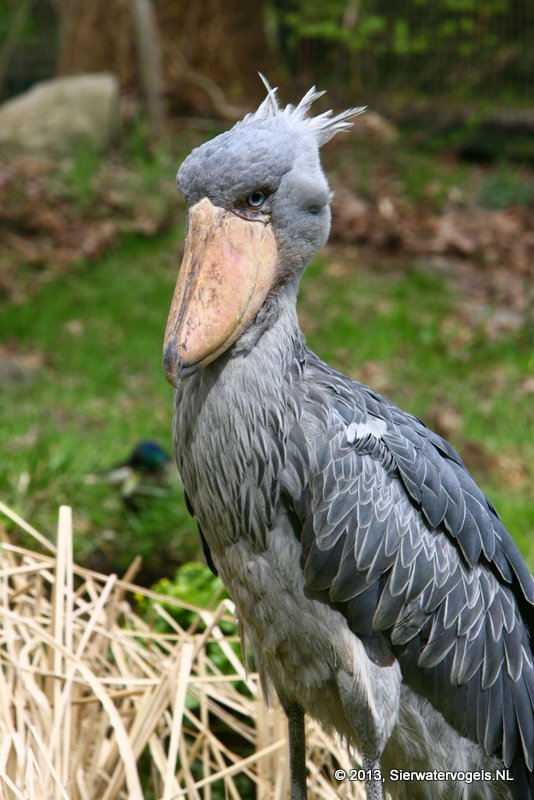
Shoebill stork (Balaeniceps rex)
De Shoebill stork
(Balaeniceps rex) is een uit de familie van de stork (Balaenicipitidae).
Naamgeving
- Nederlandse naam:
- Schoenbekooievaar
- Engelse naam:
- Shoebill stork
- Duitse naam:
- Schuhschnabel
- Franse naam:
- Bec-en-sabot du Nil
- Wetenschappelijke naam:
- Balaeniceps rex
Taxonomische indeling
- Orde:
- Pelecaniformes
- Familie:
- Balaenicipitidae
- Geslacht:
- Balaeniceps
Beschrijving
- Uiterlijke kenmerken:
Male and Female
The plumage of adult birds is blue-grey with darker slaty-grey flight feathers. The breast presents some elongated feathers, which have dark shafts.Juvenile
The juvenile has a similar plumage colour, but is a darker grey with a brown tinge. When they are first born, shoebills have a more modestly-sized bill, which is initially silvery-grey. The bill becomes more noticeably large when the chicks are 23 days old and becomes well developed by 43 days.
Maten en Gewicht
- Lengte man:
- De man (woerd) van de Shoebill stork heeft een lichaamslengte van ongeveer 110-140 centimeters. De vrouw (pop) heeft een lichaamslengte van ongeveer 110-140 centimeters.
- Gewicht man:
- Het mannetje weegt ongeveer 5600 gram. Het vrouwtje weegt ongeveer 4900 gram.
Het gewicht is notoir variabel en kan alleen als indicatie worden gebruikt!
- Notitie:
The chick takes three to fours years to reach reproductive maturity.
In captivity, the shoebill has lived as long as thirty-six years and even up to fifty years according to one report. Its lifespan in the wild is unknown.
- Breeding:
- Het vrouwtje Shoebill stork legt doorgaans zo'n 1-3 bluish-white at first, but soon become flecked with brown eieren het broeden duurt 29-31 dagen.
- Aanbevolen passende ringmaat voor de Shoebill stork is mm.De gesloten pootring kan alleen aangebracht worden bij een jonge van ongeveer dagen oud.
- It doesn't matter what leg that you band, but it's good to have a consistent system. Suggested: Left leg = Female, Right leg = Male
- Wetgeving:
- No information about regulation available

